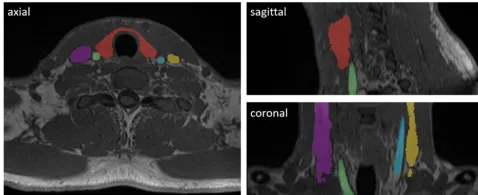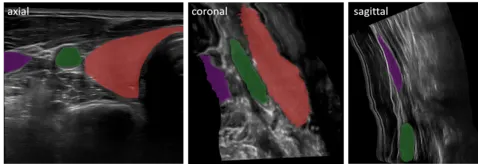Open-Access Dataset for Thyroid and Neck Segmentation
Motivation
Ultrasound (US) imaging plays a central role in the diagnosis of thyroid diseases as well as different pathologies of the neck region. Additionally, US is used for treatment planning, in the case of radioiodine therapy, and also as mean of following up on the success of different therapeutic efforts. Yet, in the vast majority of hospitals, 2D freehand US is applied. This type of examination has shown to have a high intra-observer and inter-observer variability [1], and low accuracy in terms of volume prediction in a thyroid volumetry setting using MRI as ground truth.
To tackle these problems, we propose the use of 3D US in combination with machine learning (ML) algorithms to automatically segment the most relevant organs in the region, as well as anomalies, such as nodules and tumors. 3D US can be acquired in several ways, e.g. using 3D US probes, robotic US, so-called wobbler US probes, or using freehand tracked US. The last option has gained traction over the last years as it enables to extend almost any existing commercial 2D US at a low cost. On the side of ML, its availability and increasing computing power are flooding the medical world. Yet, ML can only provide trustworthy results if sufficient (annotated) data is available to “learn” from it. This motivated us to create and publish this dataset, and thus make a relevant contribution to the community.
[1] Tracked 3D ultrasound and deep neural network-based thyroid segmentation reduce interobserver variability in thyroid volumetry; M. Krönke, C. Eilers, D. Dimova, M. Köhler, G. Buschner, L. Schweiger, L. Konstantinidou, M. Makowski, J. Nagarajah, N. Navab, W. Weber, and T. Wendler; PLOS ONE - July 29, 2022 - https://doi.org/10.1371/journal.pone.0268550
Dataset Description
Sub-dataset 1 This sub-dataset consists of 28 (healthy) volunteers who were scanned using freehand tracked ultrasonography (both sides of their neck, focus on thyroid). A Siemens Acuson NX-3 US machine, combined with a 12MHz VF12-4 probe, was adapted to be tracked using electromagnetic tracking using the Piur tUS system. Additionally, all patients were imaged with MRI (Siemens Biograph mMR) using a T1-weighted VIBE (volumetric interpolated breath-hold) sequence centered in the thyroid area of the neck. The magnetic field was set to 3T. In practical terms, each volunteer in this subdataset has:
- 1x MRI (T1-weighted VIBE sequence) of the neck area, with voxel size 0.625x0.625x1 mm3 and field of view 320x320x80 mm3.
- 9x two-sided 3D US covering the thyroid region with voxel size of 0.12x0.12x0.12 mm3 and variable field of view. The nine 3D US were acquired by three physicians (three scans each).
- Label maps for the thyroid in all MR and US images.
Sub-dataset 2 The second subdataset consists of 186 patients undergoing routinary thyroid US either as initial diagnostics means or as follow-up. The same US device and freehand tracked US extension device were used. Each patient in this sub-dataset has 6x two-sided 3D US covering the thyroid. The 6 3D US were acquired by 2 physicians (three scans each).
In both dataset, the age and the sex of the patients is included in the metadata. The dataset is currently being extended to include the labels of the trachea, the common carotid arteries, the internal jugular veins, and (if present) thyroid nodules in sub-dataset 1 (in both US and MRI), and of the same organs in sub-dataset 2 in US. See figures as examples for the multilabel annotations.
Dataset Access
The MRI and US datasets can be downloaded with the following links:
MRI dataset: https://www.campar.in.tum.de/public_datasets/2022_plosone_eilers/MRI_data.zip
US dataset: https://www.campar.in.tum.de/public_datasets/2022_plosone_eilers/US_data.zip
License
This dataset is licensed under a CC BY license. This means that users of it can distribute, shuffle, adapt, and build upon the material with the sole condition that the creators are acknowledged. The license permits commercial use as long as the authors are cited.
Added value for society
Our dataset would contribute to the improvement of thyroid diagnostics, but also neck diagnostics in general. For example, this dataset can be used to train a system for automatic segmentation of the common carotid artery a first step towards automatic detection of plaques or stenoses in it.
In particular for thyroid, algorithms based or evaluated with this dataset may provide better volumetry, improved assessment of follow-up scans, and multimodal image fusion for differential diagnosis. An accurate volumetry will potentialy have an impact on more than 20.000 cases undergoing radioiodine therapies per year in Germany, in which the volume estimation has direct impact on administered dose. A preciser follow-up can benefit up to 2 million German patients living with Morbus Basedow, or presenting suspicious thyroid nodules and undergoing a watchful waiting strategy.
Potential technical applications
This dataset enables the development of several technical applications. Among others we list:
- Multiorgan segmentation of the neck in MR and US
- MR / US (deformable) registration - sub-dataset 1 is unique as it provides paired data
- US / US (deformable) registration - paired data with up to 9 scans per patient
- Atlas generation for the neck region in MR and US
- Label noise analysis (based on multiple users, multiple scans)
- Intra- and inter-observer variability analyses
Acknowledgements
We would like to thank Dr. Markus Krönke for his enormous help while acquiring and annotating this dataset, as well, as ImFusion GmbH for providing us with software for visualizing the data (visualizations of the exemplary images are obtained using their "ImFusion Suite").

